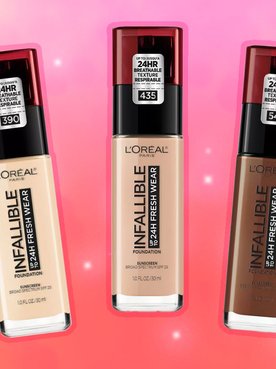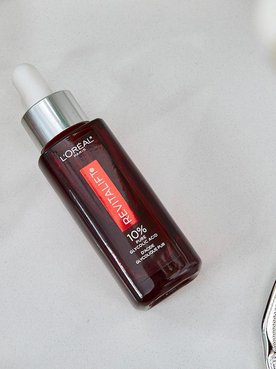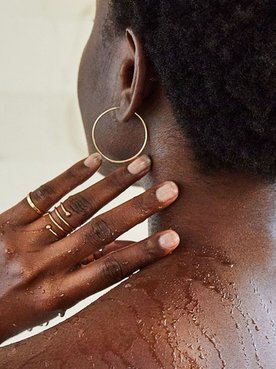Dark spots, age spots, sun spots—no matter what name they go by, these marks are an unfortunate sign of too much fun in the sun. While they are harmless, this damage can show up on the surface of your skin years down the road as visible signs of aging like sun spots or fine lines and wrinkles. So, is there anything you can do to help protect your skin and face from sun spots? And, after you have sun spots, can they go away? While your dermatologist will be able to better determine which method of addressing sun spots will be best for you and your skin, we can help to answer some of your initial questions. Keep reading to learn all about sunspots (including white sun spots), plus tips to add to your own skin care routine to help fade their appearance and prevent their return.
What Are Sun Spots?
According to the Cleveland Clinic, sun spots (also known as age spots) are flat, harmless marks that develop on the skin in areas that have had lots of sun exposure. They’re often brown or black in appearance and are extremely common, especially in those with lighter skin. These may include the face, neck, back of the hands, shoulders, upper back, and tops of the feet—but sun spots can appear anywhere on the body.
What Causes Sun Spots On Skin?
The cause of sun spots all comes back to prolonged sun exposure as the UV light from the sun speeds up the skin’s melanin production rate. Melanin is what gives your skin pigment, and when more melanin forms in a particular area, that area becomes darker— it turns into a sun spot.
What Are White Sun Spots?
Although sun spots are most commonly darker in color, white sun spots can occur after as a result of sun damage as well. The technical name for this, according to the American Osteopathic College of Dermatology, is idiopathic guttate hypomelanosis (IGH). These white spots occur when there is decreased melanin production in the skin—the opposite of dark spots. Although the full cause of IGH is unknown, it is thought that UV light exposure plays a big role in its development, which is why this skin care concern has earned the name white sun spots.
How To Help Prevent Sun Spots
1. Use Broad-spectrum Sunscreen As Directed
It’s impossible to talk about sun spots without waxing poetic about broad-spectrum sunscreen. According to the American Academy of Dermatology (AAD), wearing broad-spectrum sunscreen can help prevent the appearance of sun spots. When it comes to choosing a sunscreen, there are a variety of options, however the easiest way is by adding a moisturizer with SPF, like L’Oréal Paris REVITALIFT Triple Power Day Lotion SPF 30ning Day Moisturizer SPF 30, to your skin care routine. Combining moisturizer and broad-spectrum sunscreen into one step will help you streamline your skin care routine without sacrificing sun protection.
Editor’s note: There’s always more to know about sunscreen. For more on this important aspect of preventing sun spots, check out The Ultimate SPF Guide.
2. Take Extra Sun Protection Steps
When you’re planning a day in the sun, of course, you’ll be wearing your shortest shorts and a tank top, but for your skin’s sake—remember to bring a cover up. Also, pop on a pair of big sunglasses to help protect the delicate skin around your eyes. Then, top off the look with a wide-brimmed hat. It’s also important to remember that the sun’s rays are the most intense from 10 a.m. until 2 p.m. That means it’s a prime part of the day to stay inside or stick with lounging under a large umbrella.
3. Brighten Your Complexion
As you age, the skin’s natural ability to shed surface dead skin cells declines and sun spots can become more visible. This can make your skin look dull and less youthful. To help brighten up the look of your skin, incorporate peel pads into your nightly skin care routine. The L’Oréal Paris Revitalift Bright Reveal Brightening Daily Peel Pads, are formulated with glycolic acid and can help resurface dull, uneven tone to reveal a more youthful-looking complexion. Wipe a peel pad over your face at night, and remember to apply your broad-spectrum sunscreen in the morning since alpha hydroxy acids like glycolic acid may leave your skin more sensitive to the sun.
What To Do About Existing Sun Spots
If you already have sun spots, you’re probably wondering how you can get them to go away. While they can’t exactly disappear, by following the tips below, there are ways you can fade their appearance.
1. Laser Treatments
Laser treatments aren’t an instant sun spot removal method, but according to the AAD, they are a quick way to address them. Laser treatments also tend to have longer-lasting results than some other options. As far as side effects go, crusting or temporary darkening of the spots may occur, but the AAD states that these effects tend to fade quickly.
2. Microdermabrasion
Microdermabrasion can be used to smooth away sun spots on your face and body, per the AAD. Studies show this can be quite effective—in one study, half of the patients saw their sunspots completely disappear after multiple sessions. After microdermabrasion sessions, your skin may be red, but that will likely go away within hours.
3. Chemical Peels
The AAD names chemical peels as an effective option for fading sun spots on the hands.
Editor’s note: The AAD points out that sun spots can return, so after trying any of the above options for fading your sun spots, proper sun protection is still a must.
Next: What Does The Air Conditioner Do To Your Skin?
Photo Credit: iStock
.jpg?cx=0.56&cy=0.51&cw=2000&ch=815&hash=CBB72EA24D0DC5BEFD291E70BE4A7446)




